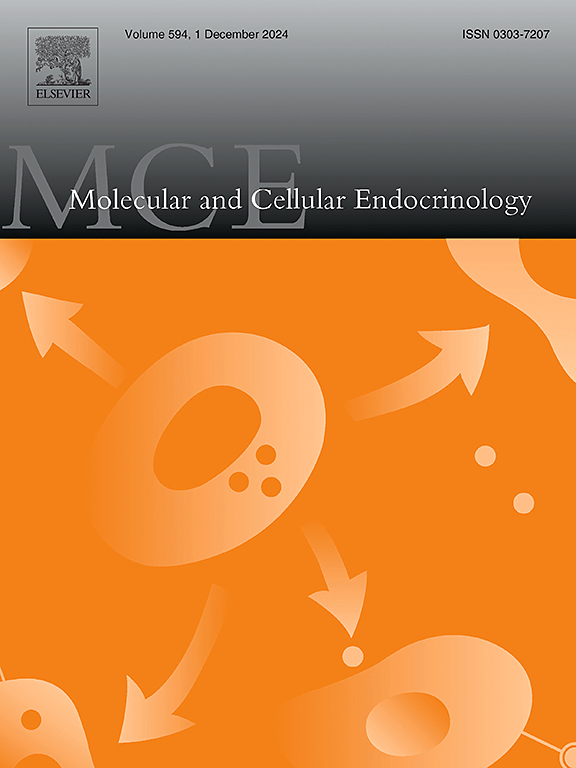ACSL5 促进糖尿病肾病近端肾小管上皮细胞的脂质沉积和脂肪凋亡。
IF 3.8
3区 医学
Q2 CELL BIOLOGY
引用次数: 0
摘要
背景:近端肾小管上皮细胞(PTC)脂质凋亡是糖尿病肾病(DKD)的重要病因,但其潜在机制仍有待进一步研究。酰基-CoA合成酶长链家族成员5(ACSL5)能促进酰基-CoA的形成,但ACSL5在DKD中PTCs脂肪凋亡中的确切作用仍无定论:方法:转录组数据分析发现了与DKD脂质代谢相关的枢纽基因Acsl5。在高脂饮食/链脲佐菌素(HFD/STZ)诱导的糖尿病小鼠和高糖/棕榈酸(HGPA)诱导的小鼠近端肾小管上皮细胞(BUMPT)中检测了ACSL5的表达。通过油红 O 染色、游离脂肪酸(FFA)ELISA 检测、Western 印迹和形态学变化来评估脂质沉积和脂肪凋亡。此外,还在 BUMPT 细胞中敲除和过表达 ACSL5,然后进行形态学评估、油红 O 染色、游离脂肪酸 ELISA 检测和 Western 印迹分析。利用 ChEA3 数据库,我们预测 STAT3 可能会转录调控 ACSL5。随后,我们敲除了 STAT3,并通过 RT-qPCR 评估了 Acsl5 的表达。此外,我们还通过 Western 印迹分析研究了 STAT3 是否会调节 ACSL5 对脂肪凋亡的影响:结果:我们首次证明了 ACSL5 在 HFD/STZ 诱导的糖尿病小鼠 PTC 中的表达显著上调,并伴随着 FATP2 表达的增加、脂质堆积和脂肪凋亡的加剧。在经 HGPA 处理的 BUMPT 细胞中,敲除 ACSL5 可减少 FATP2 的表达、脂质沉积和脂肪凋亡,而过表达 ACSL5 则可提高 FATP2 的表达并加剧这些影响。这些发现有力地表明,在糖尿病环境中,ACSL5 可能会加剧 PTC 的脂肪凋亡。从分子机制的角度来看,Stat3 基因敲除后,ACSL5 的表达减少。与单独过表达 Acsl5 相比,同时敲除 Stat3 和过表达 Acsl5 可减轻脂肪凋亡。此外,在HGPA条件下,STAT3能促进ACSL5启动子的活化:综上所述,我们的研究发现 ACSL5 是糖尿病环境下加剧肾近曲小管脂肪凋亡的重要因素。此外,我们还发现 ACSL5 受 STAT3 的转录调控。本文章由计算机程序翻译,如有差异,请以英文原文为准。
ACSL5 promotes lipid deposition and lipoapoptosis in proximal tubular epithelial cells of diabetic kidney disease
Background
Lipoapoptosis in Proximal tubular epithelial cells (PTCs) are substantial in the etiology of diabetic kidney disease (DKD), yet the underlying mechanisms warrant further investigation. Acyl-CoA synthetase long-chain family member 5 (ACSL5) facilitates the formation of acyl-CoA, however, the precise role of ACSL5 in lipoapoptosis of PTCs in DKD remains inconclusive.
Methods
Transcriptomic data analysis identified the hub gene Acsl5 associated with lipid metabolism in DKD. The expression of ACSL5 was examined in high-fat diet/streptozotocin (HFD/STZ)-induced diabetic mice and high glucose/palmitic acid (HGPA)-induced mouse proximal tubular epithelial cell (BUMPT). Oil Red O staining, free fatty acids (FFA) ELISA assay, Western Blot, and morphological changes were employed to assess lipid deposition and lipoapoptosis. Furthermore, knockdown and overexpression of ACSL5 were conducted in BUMPT cells, followed by morphological assessment, Oil Red O staining, FFA ELISA assay and Western Blot analysis. Using the ChEA3 database, we predicted that STAT3 may transcriptionally regulate ACSL5. Subsequently, we knocked down STAT3 and evaluated Acsl5 expression via RT-qPCR. Additionally, we investigated whether STAT3 modulates the impact of ACSL5 on lipoapoptosis through Western Blot analysis.
Results
We demonstrated, for the first time, a notable upregulation of ACSL5 expression in PTCs in HFD/STZ-induced diabetic mice, accompanied by increased the expression of FATP2, lipid accumulation and heightened lipoapoptosis. In HGPA-treated BUMPT cells, ACSL5 knockdown reduced the expression of FATP2, lipid deposition and lipoapoptosis, whereas its overexpression elevated the expression of FATP2 and exacerbated these effects. These findings strongly suggest that ACSL5 may exacerbate lipoapoptosis in PTCs within a diabetic milieu. From a molecular mechanism perspective, ACSL5 expression decreased after Stat3 knockdown. Concurrent knockdown of Stat3 and overexpression of Acsl5 led to a mitigation of lipoapoptosis compared to sole Acsl5 overexpression. Furthermore, STAT3 promotes the activation of ACSL5 promoter under HGPA conditions.
Conclusions
In summary, our research identified ACSL5 as an important contributor exacerbating lipoapoptosis in the renal proximal tubules within diabetic environments. In addition, we found that ACSL5 is transcriptionally regulated by STAT3.
求助全文
通过发布文献求助,成功后即可免费获取论文全文。
去求助
来源期刊

Molecular and Cellular Endocrinology
医学-内分泌学与代谢
CiteScore
9.00
自引率
2.40%
发文量
174
审稿时长
42 days
期刊介绍:
Molecular and Cellular Endocrinology was established in 1974 to meet the demand for integrated publication on all aspects related to the genetic and biochemical effects, synthesis and secretions of extracellular signals (hormones, neurotransmitters, etc.) and to the understanding of cellular regulatory mechanisms involved in hormonal control.
 求助内容:
求助内容: 应助结果提醒方式:
应助结果提醒方式:


